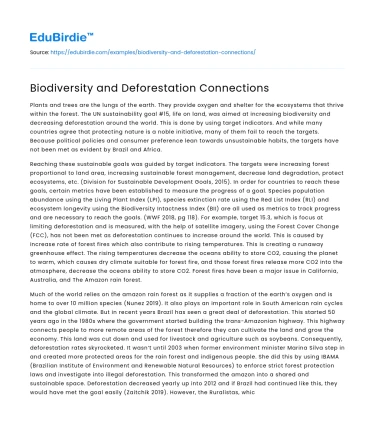Plants and trees are the lungs of the earth. They provide oxygen and shelter for the ecosystems that thrive within the forest. The UN sustainability goal #15, life on land, was aimed at increasing biodiversity and decreasing deforestation around the world. This is done by using target indicators. And while many countries agree that protecting nature is a noble initiative, many of them fail to reach the targets. Because political policies and consumer preference lean towards unsustainable habits, the targets have not been met as evident by Brazil and Africa.
Reaching these sustainable goals was guided by target indicators. The targets were increasing forest proportional to land area, increasing sustainable forest management, decrease land degradation, protect ecosystems, etc. (Division for Sustainable Development Goals, 2015). In order for countries to reach these goals, certain metrics have been established to measure the progress of a goal. Species population abundance using the Living Plant Index (LPI), species extinction rate using the Red List Index (RLI) and ecosystem longevity using the Biodiversity Intactness Index (BII) are all used as metrics to track progress and are necessary to reach the goals. (WWF 2018, pg 118). For example, target 15.3, which is focus at limiting deforestation and is measured, with the help of satellite imagery, using the Forest Cover Change (FCC), has not been met as deforestation continues to increase around the world. This is caused by increase rate of forest fires which also contribute to rising temperatures. This is creating a runaway greenhouse effect. The rising temperatures decrease the oceans ability to store CO2, causing the planet to warm, which causes dry climate suitable for forest fire, and those forest fires release more CO2 into the atmosphere, decrease the oceans ability to store CO2. Forest fires have been a major issue in California, Australia, and The Amazon rain forest.
Save your time!
We can take care of your essay
- Proper editing and formatting
- Free revision, title page, and bibliography
- Flexible prices and money-back guarantee
Much of the world relies on the amazon rain forest as it supplies a fraction of the earth’s oxygen and is home to over 10 million species (Nunez 2019). It also plays an important role in South American rain cycles and the global climate. But in recent years Brazil has seen a great deal of deforestation. This started 50 years ago in the 1980s where the government started building the trans-Amazonian highway. This highway connects people to more remote areas of the forest therefore they can cultivate the land and grow the economy. This land was cut down and used for livestock and agriculture such as soybeans. Consequently, deforestation rates skyrocketed. It wasn’t until 2003 when former environment minister Marina Silva step in and created more protected areas for the rain forest and indigenous people. She did this by using IBAMA (Brazilian Institute of Environment and Renewable Natural Resources) to enforce strict forest protection laws and investigate into illegal deforestation. This transformed the amazon into a shared and sustainable space. Deforestation decreased yearly up into 2012 and if Brazil had continued like this, they would have met the goal easily (Zaitchik 2019). However, the Ruralistas, which is a conservative party focused on agriculture, was gaining popularity and in 2018, Jair Bolsonaro became president. Due to the political landscape, IBAMA funding was cut, and increased the amount of rainforest companies are allowed to legally deforest. Setting fires is a common way to clear land and in 2019 over 80,000 fires were blazing in the amazon, more than 3 times of 2018 (Irfan 2019). In recent years, the president has allowed mining of indigenous lands (Jamasmie 2019). further leading to climate change and deforestation. All this was to say that political power plays a big role in in reaching these sustainable goals. These goals are global, however individual countries how their own goals and agendas. This is why many UN project fail such as the Green Climate Fund (GCF). The GCF goal was to raise $100 billion a year by 2020. While countries like UK, France, Germany, Norway and Sweden have donated large amounts to the fund, in contrast, Finland, Belgium, Switzerland, Italy, Japan, Portugal, and New Zealand haven’t donated anything (Ratcliff, 2019).
Which countries have contributed a lot? Northern Europe is performing best to achieve the UN sustainable development goals (See appendix). This is because the EU has made commitments to lowering greenhouse gas emissions and is making progress towards that goal to this day (European Environment Agency, 2016, pg. 35).






 Stuck on your essay?
Stuck on your essay?

